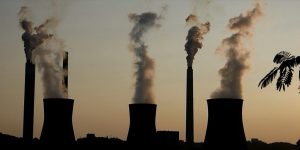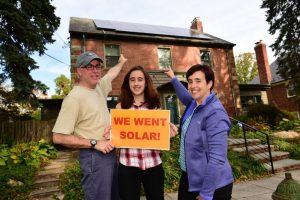- Like
- Digg
- Del
- Tumblr
- VKontakte
- Buffer
- Love This
- Odnoklassniki
- Meneame
- Blogger
- Amazon
- Yahoo Mail
- Gmail
- AOL
- Newsvine
- HackerNews
- Evernote
- MySpace
- Mail.ru
- Viadeo
- Line
- Comments
- Yummly
- SMS
- Viber
- Telegram
- Subscribe
- Skype
- Facebook Messenger
- Kakao
- LiveJournal
- Yammer
- Edgar
- Fintel
- Mix
- Instapaper
- Copy Link
A guest blog from Charleston, WV resident and engineer Allan Tweddle. During his career, he became involved in the design and application of photo-voltaic cells as early as the 1980s, as well as the design of the nine CSP (concentrated solar power) plants for Southern California Edison (SCE) during the same time period. Allan notes that, “Slowing, stopping and reversing the planetary-life threatening Anthropogenic Climate Disruptiion is the greatest job-creating economic opportunity man has ever had.”
Allan shared the following thoughts in response to an op-ed written by Llewellyn King.
Llewellyn:
 I offer the following to your op-ed, entitled “Carbon capture get starring role in future of energy” and published August 9 in our local WV Charleston Mail.
I offer the following to your op-ed, entitled “Carbon capture get starring role in future of energy” and published August 9 in our local WV Charleston Mail.
As an engineer* whose entire career has had at its core addressing air quality, I urge you to look deeper into the realities of clean, safe, GHG (greenhouse gas)-free energy as the ONLY systems we should embrace. (* ‘61 Michigan).
As a registered Professional Engineer in my native Ontario, then one who practiced in Southern California for 30 years, and now since 1998 in the “Epicenter of Climate Denial,” better known as “Friends of Coal Country” West Virginia, I have seen a lot in my air quality focused career.
When Governor Joe Manchin appointed me to the WV Public Energy Authority, we succeeded in creating a WV Department of Energy and passing a Renewable Portfolio Standard, (RPS). So have some 38 other states and D.C.
Thanks to a Republican-controlled Legislature, WV now has the dubious distinction of being the ONLY State to repeal their RPS! Rear view mirror thinking at its best!
First, CCS (carbon capture and storage) makes no financial or technical sense. It will increase the cost of coal fired power which is now no longer competitive with all the alternatives. And scientific reports I have read point out that very few of the already declining numbers of coal-fired power plants that are still in existence have the geological resources available to accommodate any CCS systems to contain the huge volumes of CO2 that they emit.
As reported in the Economist, a recent two-year independent study in England–where some of the world’s first coal-fired power plants were developed in the 19th century–concluded that CCS would increase the costs of a coal fired power plants by a minimum of 30%, but in some cases by 50%.
How is that going to make coal competitive? Aren’t we interested in finding ways to lower the cost of energy?
Even if some of the alternatives that have been suggested, that the CO2 could be captured and piped to chemical processing companies that can use it as a raw material, it still creates potential failure risk scenarios.
From an engineering standpoint, to accommodate the unique flow rates from the power plants will almost never be equal to, or balanced with, the material requirements of the chemical processes, so will still require storage and/or sequestration.
Secondly, natural gas–with reportedly lower CO2 emissions potential–does have the serious potential of methane emissions. As I’m sure you know methane is 20 times more powerful as a greenhouse gas.
As to fracking, there is now quite a body of evidence that shows this too is an environmentally dangerous and unacceptable technology that is poisoning the water tables.
We can survive without fracking, but we cannot survive without clean water.
Third, nuclear plants are also not competitive, and they are a source of enormous and seriously dangerous radioactive waste, which we are still not handling properly from the existing nuclear power plants. They are enormously expensive to build, and yes, while no one has died from those plants in this country in spite of 3 Mile Island, look what happened in Japan.
According to the BBC, an offshore earthquake caused the failure of the coastal based Fukushima plant and 18,500 people died or went missing. 160,000 people were displaced, and while no one died at the plant from the meltdown, these losses of and by the Japanese citizens were very real and certainly not acceptable.
While I lived in Southern California it became shockingly evident that the two nuclear power plants similar to Fukushima are on the coast of California and are sitting on or close to potential earthquake faults. Are they potential Fukushima failures waiting to happen?
Thankfully, SCE is decommissioning San Onofre, but PGE has yet to announce the retiring of Diablo Canyon.
California is committed to have only clean renewable energy by 2045, and was already at 32% last year. They’ve outlawed coal-fired power being imported to that state, which is the seventh largest economy in the world.
What’s wrong with that model?
Fourth, both solar energy and wind energy, with their now improved and economically feasible energy storage and back up systems, are the only systems we should be considering.
In Some jurisdictions, they are now or rapidly becoming the lowest cost means of generating electric power.
Wind is dependent on a variable source, so I prefer solar. As I’m sure you know, the sun delivers enough energy in one hour to power the entire world for a year, and is an inexhaustible and infinite source of energy.
All renewables today are still a very small percentage of our power generation, but are growing rapidly. The latest figures I could find were that they were generating 15% in 2016.
62.7 of the power came from fossil generation, coal, oil and gas. Coal was down to 30.1%.
Even with that small percentage from renewables, solar energy alone is now creating twice as many jobs than the entire fossil fuel industry sector, and has had a growth rate that is more rapid than any other job creating sector of the U.S. economy.
230,000 new jobs have been reported in 2018 by the Department of Energy in the solar energy sector alone, while the coal mining industry is down from numbers like that ten years ago to 50,000 or less today.
Just think of the number of jobs we would create if solar energy were 50% of our power generation, which it will be soon
Finally, to embrace any energy resource that emits greenhouse gases is to contribute to planetary suicide, and not at all financially or environmentally sound by all these measures and solid economic trends.
Coal and central plants with an inefficient and failing grid system are an 18th Century method of generating and distributing power whose day is over, just like manual typewriters have been replaced by laptops and “Smartphones” like I have used to write this response.
Solar is the most important, and with other renewables, the only clean, safe and both environmentally and financially sound job creating economic approach anyone should consider for the 21st Century.
I look forward to your good thoughts.
Allan Tweddle, BSE, MBA
Charleston, WV









